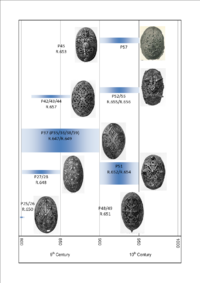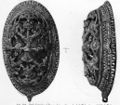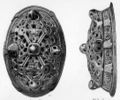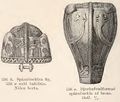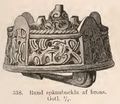Difference between revisions of "Brooches - Viking Paired Styles"
m |
m |
||
| (14 intermediate revisions by the same user not shown) | |||
| Line 1: | Line 1: | ||
{{Stars2|Category = Fastenings|Typology = Oval Brooches|TypologyFile = Brooches - Oval.png}} | {{Stars2|Category = Fastenings|Typology = Oval Brooches|TypologyFile = Brooches - Oval.png}} | ||
| − | + | {{Brooches}} | |
==Oval brooches [V/F]== | ==Oval brooches [V/F]== | ||
| − | ''Usually worn in pairs | + | ''Usually worn in pairs. The most common theory for their use was to hold up the Hangerock, a distinctive Scandinavian woman's style of dress.''<br> |
<br> | <br> | ||
Viking Age Oval brooches are larger than their Vendel precursors with typical sizes shown in the following table by Martin Rundkvist. [RUNDKVIST 2010:p.155]<br> | Viking Age Oval brooches are larger than their Vendel precursors with typical sizes shown in the following table by Martin Rundkvist. [RUNDKVIST 2010:p.155]<br> | ||
| Line 17: | Line 17: | ||
*"Each woman wears on either breast a box of iron, silver, copper or gold; the value of the box indicates the wealth of the husband. Each box has a ring from which depends a knife". Ibn Fadlan's Account of the Rus. | *"Each woman wears on either breast a box of iron, silver, copper or gold; the value of the box indicates the wealth of the husband. Each box has a ring from which depends a knife". Ibn Fadlan's Account of the Rus. | ||
|Archaeology = | |Archaeology = | ||
| − | An estimated 4000 are known from all over the Viking world | + | An estimated 4000 are known from all over the Viking world [OWEN & DALLAND 1999: p.68].<br> |
|Discussion = | |Discussion = | ||
| − | Disappear in Denmark during the C10th | + | Disappear in Denmark during the C10th [ROESDAHL 1982]<br> |
}} | }} | ||
===Berdal P11-P24=== | ===Berdal P11-P24=== | ||
| − | + | These are a transitional style between the Vendel and Viking styles.<br> | |
| − | [PETERSEN 1928:p.12-22] | + | 780AD - 850AD [RUNDKVIST 2010:p.165] <br> |
| + | [PETERSEN 1928:p.12-22]<br> | ||
<br> | <br> | ||
===P25/26 === | ===P25/26 === | ||
| + | Petersen considered the P25 brooch to be the earliest type of Viking period oval brooch. [PETERSEN 1928:p.24] | ||
<gallery> | <gallery> | ||
| − | File:R650.jpg | + | File:R650.jpg|Norway |
</gallery> | </gallery> | ||
<br> | <br> | ||
| Line 35: | Line 37: | ||
===P27/28 === | ===P27/28 === | ||
<gallery> | <gallery> | ||
| − | File:R648.jpg | + | File:R648.jpg|Norway |
</gallery> | </gallery> | ||
<br> | <br> | ||
| Line 43: | Line 45: | ||
Includes Petersen types P35, P36, P38, P39 <br> | Includes Petersen types P35, P36, P38, P39 <br> | ||
'''Archaeology'''<br> | '''Archaeology'''<br> | ||
| − | *All Viking Area’s: 500 copies | + | *All Viking Area’s: 500 copies Graham-Campbell quoting 'Paulsen 1933'[GRAHAM-CAMPBELL 1980:p.27] |
| − | *Norway: 235 copies from 217 finds | + | *Norway: 235 copies from 217 finds [PETERSEN 1928]?? |
'''Discussion'''<br> | '''Discussion'''<br> | ||
| − | P37 is the most common type found at Birka. (OWEN | + | P37 is the most common type found at Birka. (OWEN & DALLAND 1999, p.68). Accounts for 3 out of every 5 brooches from Norway and half of those found from the east. [EWING 2007: p.60]<br> |
<br> | <br> | ||
Images: V2C 101a, 101b, 101c, 101d<br> | Images: V2C 101a, 101b, 101c, 101d<br> | ||
<gallery> | <gallery> | ||
| − | File:R647.jpg | + | Hedeby_Brooch_Oval.JPG|Hedeby |
| − | File:R649.jpg | + | File:R647.jpg|Norway |
| + | File:R649.jpg|Norway | ||
</gallery> | </gallery> | ||
<br> | <br> | ||
| Line 57: | Line 60: | ||
===P42/43/44 === | ===P42/43/44 === | ||
<gallery> | <gallery> | ||
| − | File:R657.jpg | + | File:R657.jpg|Norway |
| + | Norwich-Oval_Brooches,_Santon_Downham_(Replica).JPG|England, Santon Downham | ||
</gallery> | </gallery> | ||
<br> | <br> | ||
| Line 63: | Line 67: | ||
===P45 === | ===P45 === | ||
<gallery> | <gallery> | ||
| − | File:R653.jpg | + | File:R653.jpg|Norway |
</gallery> | </gallery> | ||
<br> | <br> | ||
| Line 69: | Line 73: | ||
===P48/49 === | ===P48/49 === | ||
<gallery> | <gallery> | ||
| − | File:R651.jpg | + | File:R651.jpg|Norway |
</gallery> | </gallery> | ||
<br> | <br> | ||
===P51 - Late Oseberg Style - Double Shelled [V/F]=== | ===P51 - Late Oseberg Style - Double Shelled [V/F]=== | ||
| − | Date: Early C10th | + | Date: Early C10th<br> |
| − | + | '''Archaeology'''<br> | |
| − | + | ||
*All Viking Area’s: 1000 copies | *All Viking Area’s: 1000 copies | ||
*Norway: 469 copies from 310 finds | *Norway: 469 copies from 310 finds | ||
| − | + | '''Discussion'''<br> | |
Most common form of brooch. | Most common form of brooch. | ||
| − | |||
<br> | <br> | ||
Images: VAC 118<br> | Images: VAC 118<br> | ||
<gallery> | <gallery> | ||
| − | File:R652.jpg | + | File:R652.jpg|Norway |
| − | File:R654.jpg | + | File:R654.jpg|Norway |
</gallery> | </gallery> | ||
<br> | <br> | ||
| Line 93: | Line 95: | ||
Date: C10th. An eastern style that is rarely found in the west. <br> | Date: C10th. An eastern style that is rarely found in the west. <br> | ||
P52 are open work with a double shell. P55 are cheaper copies cast in one piece.<br> | P52 are open work with a double shell. P55 are cheaper copies cast in one piece.<br> | ||
| − | + | '''Archaeology'''<br> | |
| − | + | -- | |
| − | Very common in the east, 25% of finds. Not usually found in the west. | + | '''Discussion'''<br> |
| − | + | Very common in the east, 25% of finds. Not usually found in the west. [EWING 2007: p.60] | |
<br> | <br> | ||
Images | Images | ||
| Line 102: | Line 104: | ||
:P55 Solid - | :P55 Solid - | ||
<gallery> | <gallery> | ||
| − | File:R655.jpg | + | File:R655.jpg|Norway |
| − | File:R656.jpg | + | File:R656.jpg|Norway |
</gallery> | </gallery> | ||
<br> | <br> | ||
| Line 114: | Line 116: | ||
===Animal-head=== | ===Animal-head=== | ||
Gotland only. | Gotland only. | ||
| − | Sometimes found in 3’s | + | Sometimes found in 3’s [EWING 2007: p.60] |
| − | + | [ROESDAHL & WILSON 1992: p.192, 300 cat.274] | |
<gallery> | <gallery> | ||
| − | M532.jpg | + | M532.jpg|Sweden |
| − | M533.jpg | + | M533.jpg|Sweden |
| − | M534.jpg | + | M534.jpg|Sweden |
| − | M535.jpg | + | M535.jpg|Sweden |
| − | M536.jpg | + | M536.jpg|Sweden |
| − | M537.jpg | + | M537.jpg|Sweden |
</gallery> | </gallery> | ||
===Drum Shaped=== | ===Drum Shaped=== | ||
| − | [ROESDAHL | + | [ROESDAHL & WILSON 1992:p.254 cat.104] |
<gallery> | <gallery> | ||
| − | M531.jpg | + | M531.jpg|Sweden |
| − | M538.jpg | + | M538.jpg|Sweden |
| − | M539.jpg | + | M539.jpg|Sweden |
| − | M542.jpg | + | M542.jpg|Sweden |
</gallery> | </gallery> | ||
| + | ==References== | ||
| + | {{Ref|Ewing 2007}} | ||
| + | {{Ref|Graham-Campbell 1980}} | ||
| + | {{Ref|Owen & Dalland 1999}} | ||
| + | {{Ref|Petersen 1928}} | ||
| + | {{Ref|Roesdahl 1982}} | ||
| + | {{Ref|Roesdahl & Wilson 1992}} | ||
| + | {{Ref|Rundkvist 2010}} | ||
| + | |||
| + | <HarvardReferences /> | ||
[[Category:Fastenings]] | [[Category:Fastenings]] | ||
Latest revision as of 20:11, 26 September 2019
| Brooches - Viking Paired Styles |
|---|
|
Oval brooches [V/F]
Usually worn in pairs. The most common theory for their use was to hold up the Hangerock, a distinctive Scandinavian woman's style of dress.
Viking Age Oval brooches are larger than their Vendel precursors with typical sizes shown in the following table by Martin Rundkvist. [RUNDKVIST 2010]:p.155
Berdal. L 57–113mm
P25. L 96–103mm
P27. L 98–113mm
P37. L 96–110mm
Art
--
Literature
- "Each woman wears on either breast a box of iron, silver, copper or gold; the value of the box indicates the wealth of the husband. Each box has a ring from which depends a knife". Ibn Fadlan's Account of the Rus.
Archaeology
An estimated 4000 are known from all over the Viking world [OWEN & DALLAND 1999]:p.68.
Discussion
Disappear in Denmark during the C10th [ROESDAHL 1982]
Berdal P11-P24
These are a transitional style between the Vendel and Viking styles.
780AD - 850AD [RUNDKVIST 2010]:p.165
[PETERSEN 1928]:p.12-22
P25/26
Petersen considered the P25 brooch to be the earliest type of Viking period oval brooch. [PETERSEN 1928]:p.24
P27/28
P37 - Gripping Beast Style [V/F]
Date: C9th
Includes Petersen types P35, P36, P38, P39
Archaeology
- All Viking Area’s: 500 copies Graham-Campbell quoting 'Paulsen 1933'[GRAHAM-CAMPBELL 1980]:p.27
- Norway: 235 copies from 217 finds [PETERSEN 1928]??
Discussion
P37 is the most common type found at Birka. (OWEN & DALLAND 1999, p.68). Accounts for 3 out of every 5 brooches from Norway and half of those found from the east. [EWING 2007]:p.60
Images: V2C 101a, 101b, 101c, 101d
P42/43/44
P45
P48/49
P51 - Late Oseberg Style - Double Shelled [V/F]
Date: Early C10th
Archaeology
- All Viking Area’s: 1000 copies
- Norway: 469 copies from 310 finds
Discussion
Most common form of brooch.
Images: VAC 118
P52/55 - Baroque Style [V/F]
Date: C10th. An eastern style that is rarely found in the west.
P52 are open work with a double shell. P55 are cheaper copies cast in one piece.
Archaeology
--
Discussion
Very common in the east, 25% of finds. Not usually found in the west. [EWING 2007]:p.60
Images
- P52 Open – VAC 119, VAC 120, VAC 121
- P55 Solid -
P57 - Jellinge Style [V/F]
Gotland brooches [V/F]
Animal-head
Gotland only. Sometimes found in 3’s [EWING 2007]:p.60 [ROESDAHL & WILSON 1992]:p.192, 300 cat.274
Drum Shaped
[ROESDAHL & WILSON 1992]:p.254 cat.104
References
